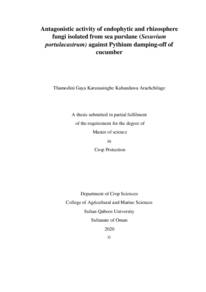Document
Antagonistic activity of endophytic and rhizosphere fungi isolated from sea purslane (Sesuvium portulacastrum) against Pythium damping-off of cucumber.
Publisher
Sultan Qaboos University.
Gregorian
2020
Language
English
English abstract
This study was conducted to investigate the antagonistic activity of endophytic and rhizosphere
fungi isolated from a medicinal plant, Sesuvium portulacastrum, against P. aphanidermatum,
the cause of damping-off of cucumber. A total of 41 endophytic and 19 rhizosphere fungi were
isolated from S. portulacastrum. Except one Basidiomycota isolate, all the other isolated fungi
belonged to the phylum Ascomycota. Five of the isolates gave above 50% suppression of P.
aphanidermatum during in vitro dual culture tests. Molecular and Phylogenetic analysis
identified all antagonists as Aspergillus insulicola A435, A. insulicola A419, and A. melleus
A412 and two rhizosphere isolates; A. terreus A213 and A. luchuensis A116. Scanning electron
microscopic studies indicated deleterious effects such as hyphae wall damage and abnormal
mycelial growths of Pythium mycelia, which were induced by all antagonists. Except for isolate
A116, the culture filtrates of the other antagonists significantly increased the electrolyte leakage
from Pythium mycelia; whereas ethyl acetate extracts of antagonists A435, A412, and A213
showed significant growth suppression. GC-MS analysis of metabolites identified a range of
antimicrobial, antifungal and plant growth promoting volatile compounds such as fatty acids,
alcohols, alkenes, ketones and triterpenes. All the five antagonists were able to produce varying
amounts of hydrolytic enzymes, such as- cellulase and β-glucanase. However, antagonist A435,
A412 and A213 showed significantly higher cellulase (0.3-02 filter paper activity/ml) activity.
Antagonist A435 and A116 showed the highest β-glucanase activity (≤ 46 units/ml). Controlled
glasshouse growth experiments supported the findings of in vitro tests and enzyme assays where
A435 and A116 showed up to 70 % control of damping-off, with 50% increased survival than
controls. The isolates A412 and A213 showed 57 % and 52 % seedling survival with up to 30-
40 % damping-off control. The lowest was A419 with only 20 % higher seedling survival than
the control. The antagonists A435, A116, and A213 also contributed to increased cucumber
shoot length, as well as shoot and root dry mass of cucumber. The synergetic effects of
metabolites and hydrolytic enzymes could be the reason for the variation between isolates in
the antagonistic activity and cucumber growth promotion.
The study identified A. insulicola A435, A. terreus A213 and A. luchuensis A116 as potential
biocontrol agents P. aphanidermatum causing damping-off of cucumber. The ability of these
isolates to inhibit other soil-borne pathogens should be investigated.
Member of
Resource URL
Category
Theses and Dissertations

